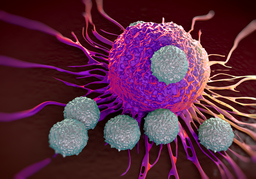Phosphatidylinositide 3-kinase Inhibitor Combined with Alpha-PD-1 Achieve Complete Remission in Metastatic Cancer
TECHNOLOGY NUMBER: 2021-366

OVERVIEW
A nanomedicine that can combine with a chemotherapy agent to inhibit cancer growth
- Remodels the immune microenvironment in both primary tumors and lymph nodes
- Re-polarizes macrophages to a state that inhibits rather than promoting cancer growth
BACKGROUND
Breast cancer is a common cause of morbidity and mortality worldwide. Twelve percent of women in the United States will be diagnosed with breast cancer, with a 5-year survival rate of 90% that falls to 27% for patients with stage IV disease. There is no long-term cure for metastatic breast cancer, though treatments can prolong life. Many factors can promote the formation of cancer metastases, including the behavior of macrophages in primary tumors and lymph nodes. Macrophages can exist in two states, either exhibiting proinflammatory (M1) or immunosuppressive (M2) interactions with the surrounding microenvironment.
Tumor-associated macrophages (TAM) located in the tumor site are usually the immunosuppressive (M2) phenotype, which encourages tumor growth and metastasis. The presence of these macrophages correlates with poor response to immunotherapy and chemotherapy. Moreover, metastasis-associated macrophages (MAMs) may be found in lymph nodes and are also thought to contribute to cancer metastasis by preparing the premetastatic microenvironment associated with the M2 phenotype. Phosphoinositide 3-kinase is known to regulate the polarization of macrophages, and a need exists to further study this protein as a target for the development of novel therapeutics.
INNOVATION
Researchers have developed a nanomedicine of Phosphoinositide 3-kinase inhibitor and the chemotherapy agent paclitaxel to remodel the immune microenvironment in both primary tumors and lymph nodes of patients with metastatic breast cancer. The goal is to combine these agents with Alpha-PD-1, an antibody directed toward a transmembrane protein in the immunoglobulin superfamily expressed on T cells, to provide a potential cure for metastatic breast cancer. The concurrent delivery of this nanomedicine with paclitaxel into the macrophages of primary tumors and their adjacent lymph nodes exhibited synergistic repolarization of macrophages from the M2 to the M1 state. This change in macrophage phenotype resulted in complete remission of metastatic breast cancer lesions in a mouse model. This treatment approach also leads to stimulation of long-term memory B cells in the bone marrow, blood, and spleen, suggesting the potential for complete remission or even cure in patients with metastatic breast cancer.
-
expand_more mode_edit Inventor (8)Duxin SunFei WenHongxiang HuLuke BugadaMahamadou DjiboRuiting LiWei GaoYudong Song
-
expand_more cloud_download Supporting documents (1)Product brochurePhosphatidylinositide 3-kinase Inhibitor Combined with Alpha-PD-1 Achieve Complete Remission in Metastatic Cancer.pdf